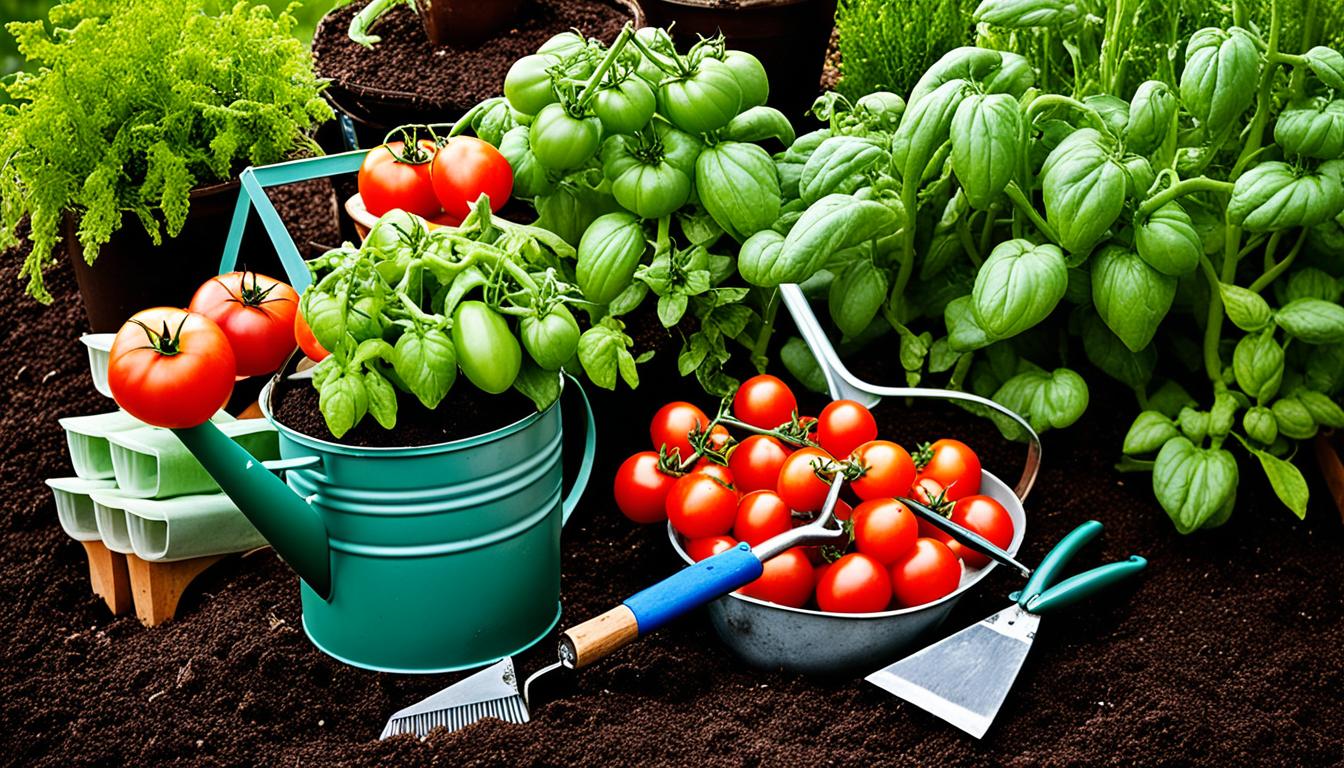Did you know a single tomato plant can make up to 50 pounds of fruit in one season? It’s why so many people love tomato gardens. As a fan of growing tomatoes, I know the right tools are needed. Things like cages, trellises, trowels, and watering cans help plants grow strong and healthy.
Tomatoes love to grow fast and need a lot of food. They need special nutrients like nitrogen and potassium. They also need micronutrients for good health. Using the right fertilizer is a must. It makes strong plants that produce lots of tasty tomatoes.
For good tomatoes, you need the right equipment. This means having items like cages and stem removers. You also need things like gloves and watering cans. There are many types of fertilizer needed, both organic and not. So, tools like soil testers and compost bins are helpful. They make sure the soil is perfect for growing tomatoes. Using tools like spreaders and sprayers help put fertilizer where it’s needed most efficiently.
Key Takeaways
- Tomato plants have specific nutritional needs that require carefully selected fertilizers and application methods.
- A variety of tools, from tomato-specific to general gardening equipment, are essential for proper fertilization and plant care.
- Soil testing, compost, and soil amendments play a crucial role in creating the optimal growing environment for tomatoes.
- Efficient application tools like spreaders, sprayers, and irrigation systems help ensure effective nutrient delivery.
- Advanced techniques and equipment, such as hydroponics and grow lights, can take tomato gardening to new levels of productivity.
Bio-fertilizer is an eco-friendly option to enhance tomato plant growth. Knowing how to safely and properly feed tomato plants is important for success. It keeps your plants healthy and your harvest plentiful.
Introduction
Tomatoes are strong and grow quickly. They need the right food all year. Things like nitrogen are vital for them. If they don’t get what they need, they won’t grow well. This can mean fewer and less tasty tomatoes.
Importance of Proper Fertilization for Tomato Plants
Gardeners need special tools for tomatoes. This includes cages and special pruning tools. They also need trowels, gloves, and watering cans. Fertilizers come in different types, so it’s important to choose the right kind. Soil testing and adding compost are also key steps. This ensures the soil is ready for planting.
For spreading fertilizers, tools like spades are needed. Understanding how to use these tools helps get more tomatoes. Grow lights and greenhouses can also help. They let you grow tomatoes in more places. This knowledge leads to a big and good tomato harvest.
Overview of Essential Tools and Equipment
Tomatoes are the most grown vegetable in the United States. Every year, over 14 million tons are grown. Most of these are used to make products. But, there are also millions grown for people to eat fresh.
Globally, people grow over 70 million tons of tomatoes. California is a big part of this. It’s the main place for tomatoes used in products. Both California and Florida lead in growing tomatoes for people to eat fresh in the United States.
Tomato-Specific Tools
Tomato plants can be bush-style or vine-like. Use cages for bush-style (determinate) ones and trellises for vine-like (indeterminate). These tools keep the plants off the ground and safe from the weather and bugs. It also makes picking the tomatoes easier. Pick cages and trellises that are strong and not made of wood. This way they will last longer and work better.
Tomato Stem Remover
Tomato stem removers make it easy to take off the stem and core of tomatoes. This keeps the tough, fibrous stem from ending up in your meals. They have a round, serrated edge you can twist to remove the stem. No knife is needed, which is safer. Every tomato grower should have one of these. They’re cheap and really helpful.
Tomato Corer
A tomato corer is like the stem remover but for removing the core and seeds. You press a button to expose the blades, then twist to take out the core. It makes taking care of tomatoes quicker and safer than using a knife. Less mess and less chance of cutting yourself. What a useful tool for tomato lovers.
Tomato Press
For canning tomatoes for sauce or paste, a tomato press is a must. It separates the skin, seeds, and pulp from the good stuff. This saves you a lot of time and hard work. This way, you get the best parts of the tomato for your recipes, without the extra work.
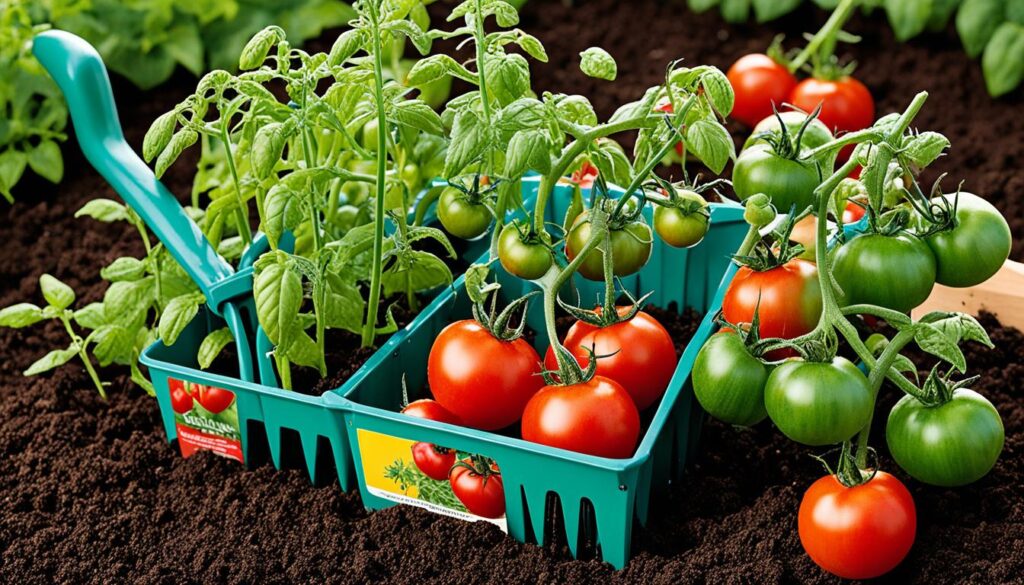
Fertilizers for Tomato Plants
Granular Fertilizers
Granular fertilizers slowly release nutrients to tomato plants. Tomato-tone Organic Fertilizer by Espoma is a top choice. It contains a 3-4-6 NPK ratio for strong tomatoes. This mix also helps keep the soil healthy. Tomatoes Alive! by Gardens Alive is another good option, with a 6-2-2 formula. Always sprinkle granular fertilizers around the plants’ base, not on the stems.
Liquid Fertilizers
Liquid fertilizers boost plants with nutrients quickly. Fish emulsion, known for helping tomatoes, has a 5-1-1 NPK ratio. Just mix with water and pour it at the plant’s base. Nutrients from liquid fertilizers can wash away. But they’re great for adding extra nutrients when needed, like when plants are flowering or setting fruit.
Organic vs. Synthetic Fertilizers
Gardeners can pick organic or synthetic fertilizers. Organic choices are things like compost, manure, and meals. They’re natural and release nutrients slowly. They also help good soil bugs. Synthetic options work faster but can hurt the soil with overuse. Many gardeners mix organic and synthetic fertilizers. This way, they provide what tomatoes need all season.
Soil Testing and Preparation
Doing a soil test is key before you fertilize your tomato plants. This test lets you check the soil’s nutrients and pH levels. It shows if your soil is missing any important nutrients. Then, you can pick the right fertilizer for your tomatoes.
Soil Testing Kits
Putting compost in your soil helps tomatoes grow strong. You can make your own compost at home. Use kitchen scraps and yard waste. Adding compost before planting gives your tomatoes a good start.
Compost Bins and Tumblers
There are also many other things you can add to the soil for tomatoes. You might add things like crushed eggshells or lime to balance the pH. These items help the plant’s roots get water and nutrients.
For missing nutrients, you can add special meals. Bone meal is good for phosphorus, blood meal for nitrogen, and kelp meal for potassium.
Soil Amendments and Conditioners
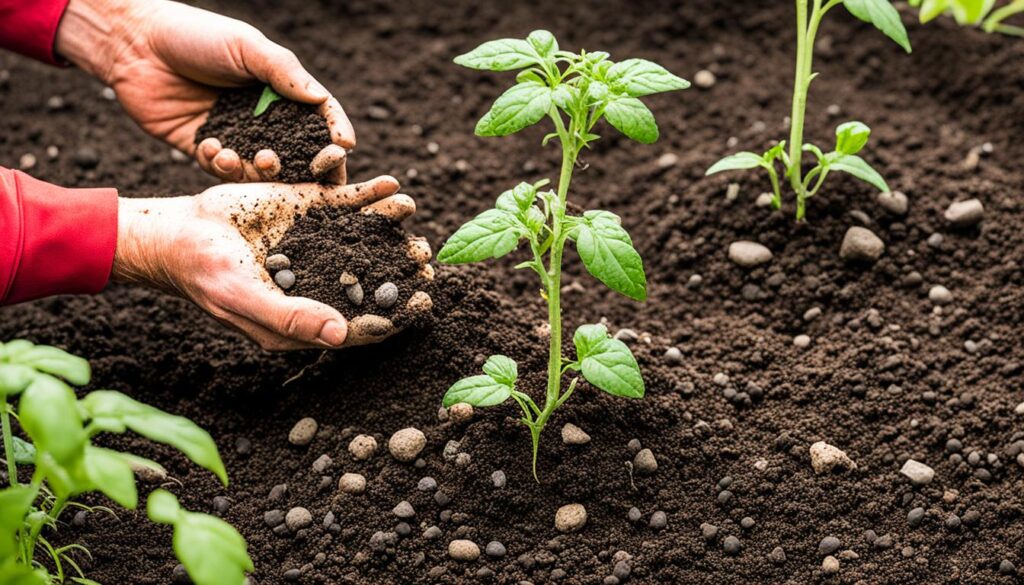
Tools and Equipment for Fertilizing Tomato Plants
Fertilizer Spreaders
Broadcast and handheld spreaders help apply granular fertilizers with ease and accuracy. They evenly spread fertilizer over a wide area or near individual plants. This ensures the fertilizer mixes well with the soil. It also prevents putting too much in one place, making the plants use the nutrients better.
Garden Sprayers and Hose-End Sprayers
Garden and hose-end sprayers are great for liquid fertilizers. They spread the fertilizer well at the plant base. Hose-end sprayers, which connect to a garden hose, mix as they spray. This makes it easier to avoid over-fertilizing and harming the plants.
Fertilizer Injectors and Drip Irrigation Systems
Fertilizer injectors and drip systems represent more advanced options. Injectors add liquid fertilizer directly to irrigation, targeting the roots. Drip systems slowly water, cutting down on wasted water and disease risks. These high-tech tools improve how plants get water and nutrients.
Gardening Tools for Tomato Plants
Tomato plants need special care, and the right tools help a lot. Tools like trowels and hand cultivators are must-haves for garden work. A strong trowel is perfect for planting holes, mixing in compost, and making the best soil for tomato roots. Hand cultivators break up soil and add fertilizers gently. Good tools, if maintained, last many seasons.
Garden Trowels and Hand Cultivators
Wearing gardening gloves keeps your hands safe while gardening. They guard against skin troubles, scratches, and harsh chemicals from fertilizers. A well-fitting pair still lets you use your hands well. This is vital when handling tomato plants, which can poke with their thorns.
Gardening Gloves
Tomato plants need the right amount of water. Watering cans and garden hoses are perfect for this job. Watering cans give water right to the roots, with no harm to the leaves. Hoses, especially those you can adjust, make it easy to water a lot of plants or just one.
Watering Cans and Hoses

Advanced Tools and Equipment
For tomato gardeners looking to start early or grow longer, lights and greenhouses are key. Grow lights help start seeds inside, perfect for early starts. Then, move them outside stronger. Greenhouses, either bought or built, offer a perfect space for tomatoes. They mean bigger harvests and possible year-round growing. These options are pricier but big steps for serious gardeners.
Hydroponic gardening, growing without soil, is on the rise for tomatoes. This way, you control the nutrients and conditions, making fruits taste better and grow more. It’s a bit harder than the usual way, but it’s a great choice for those short on garden space. You’ll need special gear and some know-how to get it right.
Checking the soil’s pH and how wet it is matters a lot for tomatoes. A pH meter tests the soil’s level, which should be 6.2 to 6.8 for best tomato growing. A moisture meter tells you when to water, stopping you from doing it too much or too little. These meters help pick the right fertilizers and watering times. The result? Happier and more tomatoes from your plants.
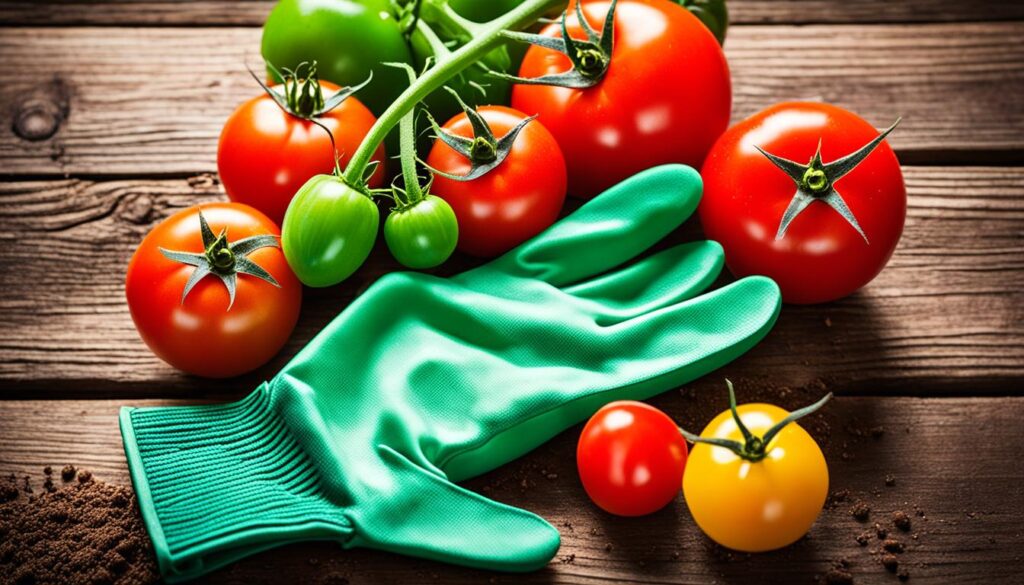
Organic Fertilizer Options
Compost and well-aged animal manure are great for tomato plants. They are full of important nutrients like nitrogen, phosphorus, and potassium. These also make the soil better and help good microbes grow.
Adding them to the soil before planting tomatoes is smart. Also, you can use manure from cows, horses, or sheep. They are easy to find and are good for the soil too.
Plant-Based Fertilizers
There are plant-based options too, like alfalfa meal and kelp meal. Alfalfa meal adds nitrogen, while kelp meal gives potassium. Bone meal has phosphorus, and blood meal has lots of nitrogen. Mixing several of these can give tomatoes the nutrients they need.
Making Homemade Organic Fertilizers
Gardeners can mix their own fertilizers with items they have at home. This can include compost, manure, eggshells, coffee grounds, and more. Mixing these allows you to give your tomatoes just what they need. Plus, you control what goes in, making it good for the environment.
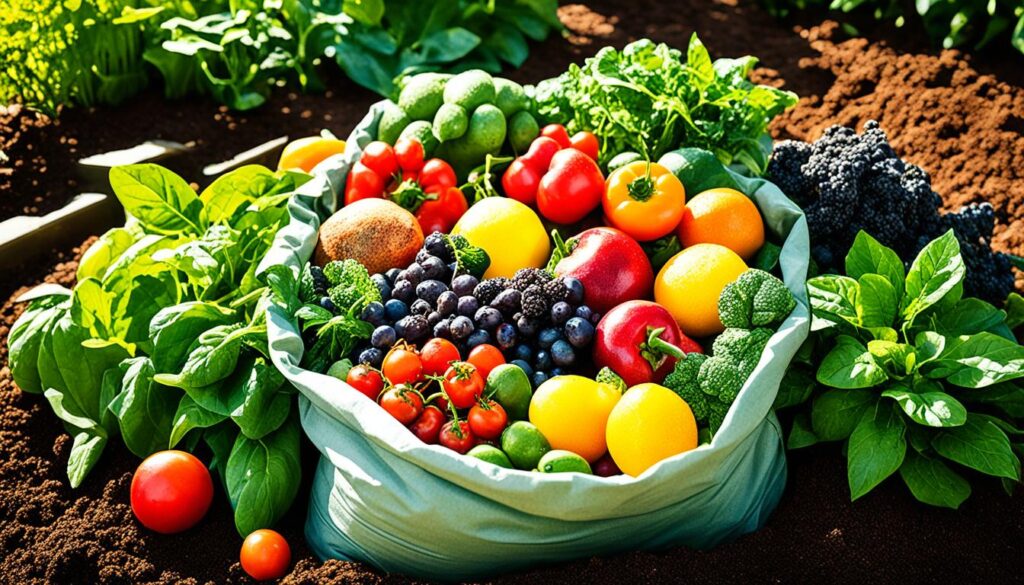
Application and Maintenance
It’s key to apply fertilizers correctly for healthy tomato plants. Granular types should be put into the soil, not too close to the plant to prevent burning. For liquid fertilizers, mix them with water first and then pour near the plants. Always use the right amount as directed. This prevents too much fertilizer which is harmful. The goal is to help the plants get all the right nutrients without any problems.
Fertilizing Schedule and Frequency
Tomato plants need different nutrients as they grow. Early on, they need nitrogen for leaves and stems. Later, around flowering and fruiting, they need phosphorus and potassium for fruits. To feed them right, use mainly nitrogen fertilizer when planting. Then switch to phosphorus fertilizer as they bloom. As fruits grow, change to a potassium fertilizer. Doing this at the right time keeps your plants healthy and full of tomatoes.
Storing and Handling Fertilizers Safely
It’s crucial to store and use fertilizers safely. Keep them in a cool, dry spot out of reach of kids and pets. When you use them, wear gloves to keep your skin safe. Don’t let granular fertilizers touch the plant stems. It can hurt the roots. For liquids, always mix them with water first. By being careful with how you store and apply fertilizers, you can help your plants grow without any danger.

Troubleshooting and Tips
To have a lot of tomatoes, you need to fix issues and change how you fertilize. Often, the problem is the soil’s pH. Tomatoes like a pH of 6.2 to 6.8. You can use a soil test kit to check the pH. Then, if needed, add lime or sulfur to fix it.
Tomatoes may not get enough nutrients, showing in different ways. For lack of nitrogen, their leaves turn yellow. A phosphorus shortage makes them purple. If they lack potassium, their leaf edges turn yellow. Use a balanced fertilizer with NPK of 20-10-10, 16-6-4, or 10-20-10 to help. This will make your plants healthier and give more tomatoes.
Yet, too much fertilizer can make the plants grow a lot of leaves but not many fruits. Always follow the fertilizers’ guidelines. Use them at the right plant stages, like when you first plant them, when they start to flower, and when they produce fruits. Remember not to let the fertilizer touch the plant stems, to avoid hurting the plants. Watch your plants closely. Adjust how you fertilize as needed. This way, you’ll get many tasty tomatoes.
FAQ about Tools And Equipment For Fertilizing Tomato Plants
What are the essential tools and equipment for fertilizing tomato plants?
For tomato plants, you need tools like cages and trellises to help them grow. Also, stem removers and corers are useful for preparing them. Garden tools such as trowels and gloves are necessary too. Don’t forget about watering cans. You’ll also need fertilizers, soil testing kits, and amendments for the soil. To apply these, equipment like sprayers and irrigation systems come in handy.
Why is proper fertilization important for tomato plants?
Tomatoes grow very quickly and need a lot of food. They require specific nutrients to be healthy and produce fruit. Proper fertilizer helps them grow strong, and you’ll get more tomatoes.
What are the different types of tomato-specific tools and how do they help with gardening?
To help tomatoes grow, you can use cages and trellises. Stem removers and corers make preparing them easier. These tools help your tomato garden thrive.
What are the differences between granular and liquid fertilizers for tomatoes?
Granular fertilizers release nutrients slowly, while liquids are fast. A mix of both can be great for tomatoes. This helps meet the plants’ needs all season.
How do I prepare the soil for optimal tomato growth?
Start by testing the soil to see what it needs. Adding compost and important minerals makes the soil perfect for tomatoes.
What tools and equipment are used for efficiently applying fertilizers to tomato plants?
Fertilizer spreaders and sprayers help with applying nutrients. These tools make it easier to feed your tomato plants. Injectors and irrigation systems add precision to fertilization.
What are some of the basic gardening tools needed for tending to tomato plants?
You’ll need trowels and cultivators for the soil, plus gloves to protect your hands. Watering cans and hoses are necessary for keeping the plants moist.
How can advanced tools and equipment enhance tomato gardening?
Advanced tools like grow lights and greenhouses boost your tomato season. Hydroponics create a perfect growing environment. Meters help monitor essential plant conditions.
What are some good organic fertilizer options for tomato plants?
Organic choices include compost and various meals. These not only feed your plants but they also help the soil. You can mix your own organic fertilizers too.
How do I properly apply and maintain fertilizers for my tomato plants?
For granular fertilizer, work it into the soil near the plants. Liquid fertilizers should be poured around the base. Change the type and amount of fertilizer as your plants grow. Remember to keep fertilizers safe and dry.
Source Links
- https://www.homebiogas.com/blog/tomato-fertilizer/
- https://extension.uga.edu/publications/detail.html?number=B1312&title=commercial-tomato-production-handbook
- https://foodgardening.mequoda.com/articles/essential-tools-and-equipment-for-growing-tomatoes/
- https://extension.okstate.edu/fact-sheets/print-publications/hla/growing-tomatoes-in-the-home-garden-hla-6012.pdf
- https://extension.okstate.edu/fact-sheets/growing-tomatoes-in-the-home-garden-2.html
- https://sowrightseeds.com/blogs/planters-library/complete-guide-to-fertilizing-tomatoes
